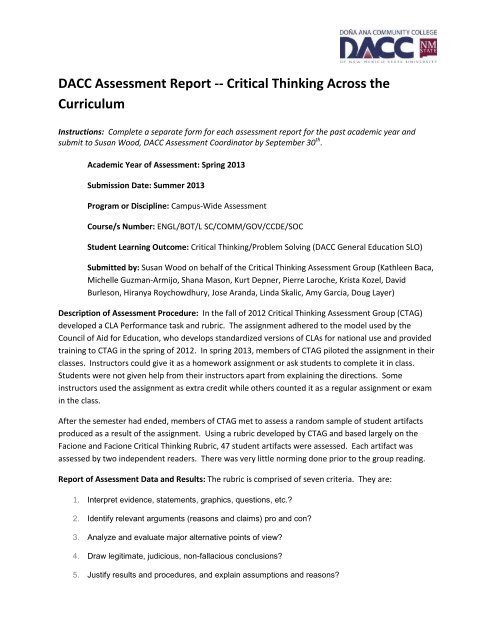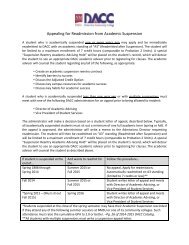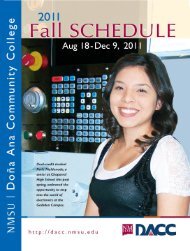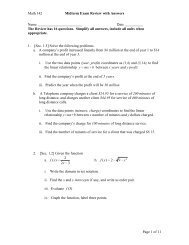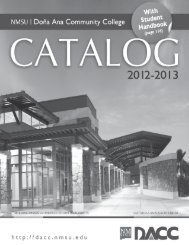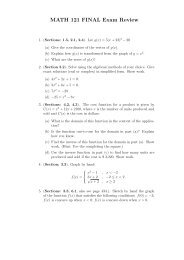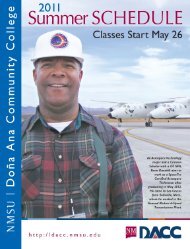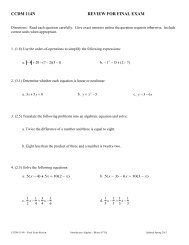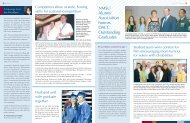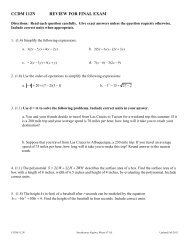Critical Thinking Assessment Report 12/13 AY
Critical Thinking Assessment Report 12/13 AY
Critical Thinking Assessment Report 12/13 AY
You also want an ePaper? Increase the reach of your titles
YUMPU automatically turns print PDFs into web optimized ePapers that Google loves.
DACC <strong>Assessment</strong> <strong>Report</strong> -- <strong>Critical</strong> <strong>Thinking</strong> Across the<br />
Curriculum<br />
Instructions: Complete a separate form for each assessment report for the past academic year and<br />
submit to Susan Wood, DACC <strong>Assessment</strong> Coordinator by September 30 th .<br />
Academic Year of <strong>Assessment</strong>: Spring 20<strong>13</strong><br />
Submission Date: Summer 20<strong>13</strong><br />
Program or Discipline: Campus-Wide <strong>Assessment</strong><br />
Course/s Number: ENGL/BOT/L SC/COMM/GOV/CCDE/SOC<br />
Student Learning Outcome: <strong>Critical</strong> <strong>Thinking</strong>/Problem Solving (DACC General Education SLO)<br />
Submitted by: Susan Wood on behalf of the <strong>Critical</strong> <strong>Thinking</strong> <strong>Assessment</strong> Group (Kathleen Baca,<br />
Michelle Guzman-Armijo, Shana Mason, Kurt Depner, Pierre Laroche, Krista Kozel, David<br />
Burleson, Hiranya Roychowdhury, Jose Aranda, Linda Skalic, Amy Garcia, Doug Layer)<br />
Description of <strong>Assessment</strong> Procedure: In the fall of 20<strong>12</strong> <strong>Critical</strong> <strong>Thinking</strong> <strong>Assessment</strong> Group (CTAG)<br />
developed a CLA Performance task and rubric. The assignment adhered to the model used by the<br />
Council of Aid for Education, who develops standardized versions of CLAs for national use and provided<br />
training to CTAG in the spring of 20<strong>12</strong>. In spring 20<strong>13</strong>, members of CTAG piloted the assignment in their<br />
classes. Instructors could give it as a homework assignment or ask students to complete it in class.<br />
Students were not given help from their instructors apart from explaining the directions. Some<br />
instructors used the assignment as extra credit while others counted it as a regular assignment or exam<br />
in the class.<br />
After the semester had ended, members of CTAG met to assess a random sample of student artifacts<br />
produced as a result of the assignment. Using a rubric developed by CTAG and based largely on the<br />
Facione and Facione <strong>Critical</strong> <strong>Thinking</strong> Rubric, 47 student artifacts were assessed. Each artifact was<br />
assessed by two independent readers. There was very little norming done prior to the group reading.<br />
<strong>Report</strong> of <strong>Assessment</strong> Data and Results: The rubric is comprised of seven criteria. They are:<br />
1. Interpret evidence, statements, graphics, questions, etc.?<br />
2. Identify relevant arguments (reasons and claims) pro and con?<br />
3. Analyze and evaluate major alternative points of view?<br />
4. Draw legitimate, judicious, non-fallacious conclusions?<br />
5. Justify results and procedures, and explain assumptions and reasons?
6. Follow where evidence and reasons lead?<br />
7. Adhere to the conventions of Standardized American English?<br />
Each reader gave a score of 1, 2, 3 or 4 to each criterion.<br />
1=very poor or missing<br />
2=poor/weak<br />
3=okay/satisfactory<br />
4=strong/excellent<br />
A score of 3 or 4 is considered acceptable; a score of 1 or 2 is considered not acceptable.<br />
Of the seven criteria, on criterion 7 had an average that was acceptable; all others had averages that<br />
were in the unacceptable range. The follow graph provides a visual of the averages:<br />
Data were also collected on how many of the artifacts were in-class versus out-of-class assignments.<br />
There were 19 in-class assignment artifacts and 28 out-of-class assignment artifacts.<br />
Data were also compiled regarding splits. A split is considered any reading by the two independent<br />
readers that bridged the acceptable/unacceptable range. In other words, if one reader gave a criterion<br />
on a particular artifact a 4 and the second reader gave the same criterion on the same artifact a 2, this is<br />
considered a split. Given that there were 47 artifacts assessed and each artifacts was scored for seven<br />
criteria, that provides 329 separate pairs to examine for splits. Of the 329 pairs, 49 had splits, which is<br />
15%. Another way to look at splits is by artifact. Of the 47 artifacts, there was at least one criterion over
which the two readers split in 27 of the artifacts; this means that 57% of the artifacts yielded at least<br />
one criterion that produced a split.<br />
The following graphs show results for out-of-class versus in-class options:<br />
Whilte the trends are basically the same, the in-class option seems to produce better results, as shown<br />
in the overall score average (28 points possible):
Analysis and Interpretation/Reflection on Results or Trends: Based on the data and the experience, the<br />
group’s consensus is that:<br />
1. as a school, we need to address how to incorporate more critical thinking into the curriculum –<br />
especially since this is one of our general education SLOs.<br />
2. the assignment and rubric need to be tweaked to better assess critical thinking<br />
3. the procedure needs to be tweaked to produce more reliable data<br />
4. faculty need to be normed at the beginning of the semester to the rubric so that there will be<br />
fewer splits and more valid results<br />
5. the curriculum in ENGL 111 may need to be examined and adjusted to provide a better<br />
foundation for critical thinking<br />
6. work done in a more controlled environment (in-class) produces better results<br />
Plan for Improving the <strong>Assessment</strong> Process and/or Student Learning: The following lists CTAG’s plan for<br />
improving this assessment:<br />
1. create one or two new CLAs in fall semester<br />
a. make sure questions are obviously not open-ended<br />
b. create a grading key to accompany each CLA<br />
2. provide students with some brief material regarding the function and form of a memo<br />
3. include as one of the CLA task a request for students to create a matrix of sorts that shows<br />
which documents they thought were useful and valid, and which ones weren’t<br />
4. revise the rubric and reorder the criteria<br />
5. be clear how many documents students to refer to and reflect this requirement in the rubric
6. set up a norming session at the beginning of the semester and before the common reading<br />
7. invite a few more classes to participate in the spring 2014 assessment, including part-time<br />
faculty<br />
8. require that the memo students produce be written in-class rather than as a homework<br />
assignment<br />
9. address how to cite the documents provided in either the assignment or the rubric<br />
10. provide professional development to more DACC faculty to better teach and assess critical<br />
thinking


